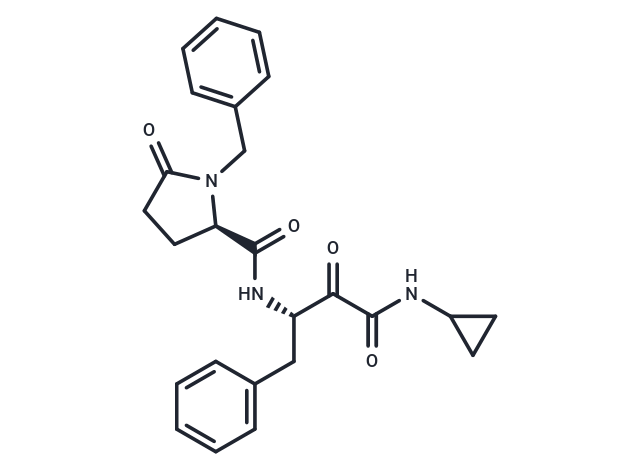Shopping Cart
Remove All Your shopping cart is currently empty
Your shopping cart is currently empty
(1S,2R)-Alicapistat ((1S,2R)-ABT-957) is a highly efficient, orally active compound that selectively inhibits human calpains 1 and 2, showing promise for Alzheimer's disease (AD) therapy [1]. It effectively addresses the metabolic liability associated with carbonyl reduction and demonstrates potent inhibition of calpain 1 with an IC50 value of 395 nM [2].

| Pack Size | Price | USA Warehouse | Global Warehouse | Quantity |
|---|---|---|---|---|
| 1 mg | $62 | In Stock | In Stock | |
| 5 mg | $153 | In Stock | In Stock | |
| 10 mg | $219 | In Stock | In Stock | |
| 25 mg | $333 | In Stock | In Stock | |
| 50 mg | $445 | In Stock | In Stock | |
| 100 mg | $596 | In Stock | In Stock | |
| 1 mL x 10 mM (in DMSO) | $179 | In Stock | In Stock |
| Description | (1S,2R)-Alicapistat ((1S,2R)-ABT-957) is a highly efficient, orally active compound that selectively inhibits human calpains 1 and 2, showing promise for Alzheimer's disease (AD) therapy [1]. It effectively addresses the metabolic liability associated with carbonyl reduction and demonstrates potent inhibition of calpain 1 with an IC50 value of 395 nM [2]. |
| In vitro | (1S,2R)-Alicapistat fails to achieve sufficient concentrations in the central nervous system (CNS) for a pharmacodynamic effect [1]. It inhibits Calpain 1 (μ-calpain) and 2 (m-calpain) in a calcium-dependent manner, requiring μ-molar or m-molar calcium concentrations for activation. At 100 nM, (1S,2R)-Alicapistat (compound 22) prevents deficits in synaptic transmission caused by Aβ oligomer in rats [2]. Furthermore, at 385 nM, it effectively prevents NMDA-induced neurodegeneration and amyloid beta (Aβ)-induced synaptic dysfunction [2]. At concentrations ranging from 9-21 nM in cerebrospinal fluid (CSF), (1S,2R)-Alicapistat does not reach the IC 50 required for calpain inhibition, yet it exhibits no dose-limiting toxicities (DLTs) across broad population studies [3]. |
| In vivo | '(1S,2R)-Alicapistat (compound 22), administered intravenously (iv) or orally (po) at doses of 1-3 mg/kg, shows moderate plasma clearance rates (CLp) in mouse, rat, and dog (0.13-1.04 L/hr.kg) and higher rates in monkeys (1.98 L/hr.kg). The average steady-state volume of distribution (Vss) is moderate in mouse, dog, and monkey (0.64-1.8 L/kg), with rats displaying higher values (3.4 L/kg). The plasma elimination half-life (t 1/2) varies, being shortest in dogs (1.7 hours), 2.3 hours in monkeys, and approximately 6.0 hours in mice and rats. Oral bioavailability (F) is high in mice, rats, and dogs (>80%) but moderate in monkeys (14%) [2].' |
| Molecular Weight | 433.5 |
| Formula | C25H27N3O4 |
| Cas No. | 2221010-57-5 |
| Smiles | O=C(N[C@@H](Cc1ccccc1)C(=O)C(=O)NC1CC1)[C@H]1CCC(=O)N1Cc1ccccc1 |
| Relative Density. | 1.29 g/cm3 (Predicted) |
| Color | White |
| Appearance | Solid |
| Storage | Powder: -20°C for 3 years | In solvent: -80°C for 1 year | Shipping with blue ice/Shipping at ambient temperature. | |||||||||||||||||||||||||||||||||||
| Solubility Information | DMSO: 45 mg/mL (103.81 mM), Sonication is recommended. | |||||||||||||||||||||||||||||||||||
| In Vivo Formulation | 10% DMSO+40% PEG300+5% Tween 80+45% Saline: 1 mg/mL (2.31 mM), Sonication is recommended. Please add the solvents sequentially, clarifying the solution as much as possible before adding the next one. Dissolve by heating and/or sonication if necessary. Working solution is recommended to be prepared and used immediately. The formulation provided above is for reference purposes only. In vivo formulations may vary and should be modified based on specific experimental conditions. | |||||||||||||||||||||||||||||||||||
Solution Preparation Table | ||||||||||||||||||||||||||||||||||||
DMSO
| ||||||||||||||||||||||||||||||||||||
| Size | Quantity | Unit Price | Amount | Operation |
|---|

Copyright © 2015-2025 TargetMol Chemicals Inc. All Rights Reserved.